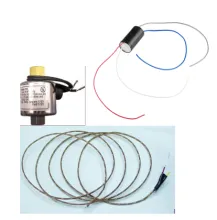http://louisthiery.com/wp-content/uploads/2013/01/Diagram1.png
This project can be broken down into three interchangeable modules listed in the block diagram above.
The Thermocouple Amplifier
Since we will be measuring how hot the flame weeder gets with a flame, we need to use a sensor that tolerates such high temperatures. This makes thermocouples a sound choice. The challenge with thermocouples is the sensor itself only provides a signal to the order of microvolts (µV) so an amplifier is absolutely necessary.
For now, we've only tried out the AD595AQ available at SparkFun or at Digikey for a little less. The accuracy is only guaranteed t ±3°C but that is just fine for us to figure out whether there is fire or not!
Logic
Regardless of the system, we need to get 5V from the 12V battery. An LDO voltage regulator such as the Texas Instruments LM1084IT-5.0/NOPB has worked so far and is available at Digikey. It's key attribute is its ability to supply 5A - the spark gap needs over 3A to operate!
The logic will need to process the amplified thermocouple readings and decide when to switch on and off the spark gap.
Digital
Here's the arduino code that will get this thing sparking when the temperature measured by the thermocouple falls beneath a set threshold
(it's still really choppy): https://gist.github.com/4237798.js?file=sparky.c
Analog
(under development)
Spark Gap
We need a way to ignite the propane so a fly-back transformer or spark gap (similar to a spark plug) is needed. This 4.8V spark gap igniter from Spark Fun works nicely because it can run at 5V just like our logic circuit; however it runs at 3A requiring a particular voltage regulator. It would be interesting to find a 12V spark gap and see if it will runs straight from the battery. It would allow us to select a cheaper voltage regulator which won't need to source the 3A necessary.
A MOSFET is also necessary to allow the logic to drive the the spark gap while buffering it from the high amounts of current. This MOSFET, available from Digikey, has worked so far and will tolerate a 12V spark gap should that change.
If you have the spark gap being activated periodically, a capacitor with the positive terminal attached before the device with negative terminal grounded will enable the necessary inrush of current. The larger the capacitor is the larger you can allow the gap that you are sparking across to be.
http://louisthiery.com/wp-content/uploads/2013/01/sparkgap.png
